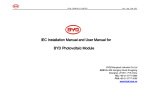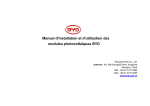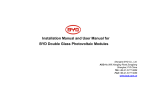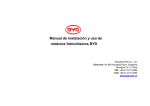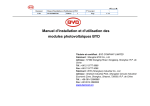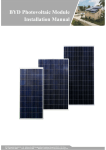Download Installation Manual and User Manual for BYD Photovoltaic Modules
Transcript
Installation Manual and User Manual for BYD Photovoltaic Modules Shanghai BYD Co., Ltd. ADD:No.999 Xiangjing Road,Songjiang Shanghai, P.R.China TEL:+86-21-5777 8888 FAX:+86-21-5777 5086 www.byd.com.cn BYD COMPANY LIMITED Rev. Jan. 8th 2013 CONTENT Foreword ............................................................................................................................................................................................................................................... 3 1. Product identification ...................................................................................................................................................................................................................... 3 1.1 Label .............................................................................................................................................................................................................................................................. 3 1.2 Barcode ......................................................................................................................................................................................................................................................... 3 2. Transportation and storage manual .............................................................................................................................................................................................. 4 3. Installation ........................................................................................................................................................................................................................................ 4 3.1 Warning ......................................................................................................................................................................................................................................................... 4 3.2 Mechanical installation ............................................................................................................................................................................................................................... 5 3.2.1 Mounting system .................................................................................................................................................................................................................................. 5 3.2.2 Clamping ............................................................................................................................................................................................................................................... 7 3.2.3 Insertion system ................................................................................................................................................................................................................................... 8 3.3 Electric installation ..................................................................................................................................................................................................................................... 10 3.3.1 Grounding ............................................................................................................................................................................................................................................ 10 3.3.2 General Installation ............................................................................................................................................................................................................................ 10 4. Maintenance and Care .................................................................................................................................................................................................................. 12 4.1General Maintenance ................................................................................................................................................................................................................................. 12 4.2 Module Cleaning ........................................................................................................................................................................................................................................ 13 5.Claim .............................................................................................................................................................................................................................................. 13 2 BYD COMPANY LIMITED Foreword This manual describes the transportation, installation and maintenance of PV modules (hereafter referred to as “module”). Please read this manual carefully before installing and using the modules. Please get in touch with the provider if you have any questions. This manual applies to all the standard modules of BYD Company Limited. Keep this guide in a safe place for future reference (care and maintenance) and in case of sale or disposal of the modules. NOTE: All statements in this manual refer to our 3 bus-bar polycrystalline cell PV modules as well as to our monocrystalline cell modules. The illustrations in this manual, which show 2 bus-bar cell PV modules, are only used for reference purposes. 1. Product identification 1.1 Label The label shows the product type, rated power, rated current, rated voltage, open circuit voltage, short circuit current, weight, dimensions etc.; 3 Rev. Jan. 8th 2013 1.2 Barcode Each module has only one bar code as shown below: Bar code-A Bar code-B SH 120220 P630 AS68- 001 SH 120820 P630 AS68C001 SH——Manufacturer location, Shanghai; 120220——Date(YYMMDD; P——“P” for Poly –Si, “M” for Mono–Si, “L” for Mono-like Si; 6——“6” for the cell dimension of 156*156mm,“5” for the cell dimension of 125*125mm; 30——the voltage of the modules; AS68- or AS68C——Engineering Code ,referring to different shifts, materials etc; 001——Number of product components, three digit sequence 0 to 999 for sequential production starting on each new day of production at 001. BYD COMPANY LIMITED 2. Transportation and storage manual Please observe the following criteria after packing: (1) Don’t tilt the packing boxes for more than 15° during handing. (2)Please follow the instruction labels “up” and “down” during placing the packing boxes and avoid placing them upside down during transit. (3)Be careful while handing the boxes during transit, and avoid heavy pressure or jolting of the boxes. (4)The packing boxes should be protected from rain. (5)Transportation conditions should conform to the requirements of the packing boxes and of the modules regarding their environmental conditions. 3. Installation 3.1 Warning (1) Do not use mirrors or other magnifiers to artificially concentrate sunlight on the module. (2) Do not touch the connectors with bare hands and use insulated tools during electrical work. (3) Although the glass surface of the modules is rather durable and able to withstand pressure, the glass might break (and the module will no longer work properly), if it is dropped or hit by tools or other heavy objects. 4 Rev. Jan. 8th 2013 (4) Under certain conditions, the module might produce a higher electric current and/or voltage than measured under standard test conditions. Accordingly, the values of Isc and Voc marked on this module should be multiplied by 1.25 when determining the component voltage ratings, conductor current ratings, fuse sizes and size of controls relating to the PV output. (5) The installation work of the PV array can only be done under the protection of sun-sheltering covers or sunshades, and only qualified persons should install modules or perform maintenance work. (6) Systems should be installed by qualified personnel only and at least by two persons. The system involves electricity and can be dangerous if the personnel are not familiar with the appropriate safety procedures. (7) Follow the recommendations of the battery manufacturer if batteries are used with the modules. Please observe national and local laws and regulations when installing modules. If required, an architecture license should be obtained before carrying out this work. (8) Please unpack carefully. (9) A visual inspection should be carried out before installation, in order to make sure that there is no defect in the packing, the junction box or on the surface of module. (10)The user should design and select a metallic bracket for installing that is suitable to bear the weight of the PV modules. The brackets should be selected by the user according to their destined places of installation, such as open land or a rooftop. For safety reasons, all brackets should be grounded. In order to insure good BYD COMPANY LIMITED conductivity, electroplated brackets should be used. (11)As a general rule, PV modules should be installed in a location where they will receive maximum sunlight throughout the year. In the Northern Hemisphere, the modules should typically face south, and in the Southern Hemisphere, the modules should typically face north. When choosing a site, avoid trees, buildings or other obstructions, which might block the sunrays. When selecting a clamping or insertion system, appropriate anticorrosive brackets should be selected according to the specification of the module. (12) Put the modules on the frame and tighten the screws after putting on the underlying washers. Don't cover the drain holes with other components when installing the modules. The junction box should be placed at the top of the module in order to facilitate correct positioning of ventilation holes. (13)Don’t grasp the junction box or cables during the installation process. (14) In case of installing the module on a roof top, the roof top should be made fire-resistant first. Do not use modules near equipment or in places where flammable gases may be generated. (15)In case of roof top installation, the PV array should fulfill the requirements regarding fire resistance of the norm IEC 61730-2. (16)The ambient temperature range at the location of installation should not exceed -40°C ~+85°C. (17) Do not connect/disconnect modules under load. Rev. Jan. 8th 2013 DANGER: One single module may generate more than 30V DC when its front is exposed to direct sunlight. If modules are connected in series, the total voltage is equal to the sum of the partial voltages of each module. If modules are connected in parallel, the total current is equal to the sum of the partial currents of each module. Therefore direct contact should be avoided after installing a greater number of modules in series or parallel, in order to avoid electric shocks. CAUTION: Please unpack the module in an appropriate environment, and use special tools. The modules need to be kept water-proof and damp-proof. NOTE: BYD does not limit the materials of the installation as long as they can be used outdoors for at least 25 years. 3.2 Mechanical installation 3.2.1 Mounting system Use screws put through the mounting holes according to the following figure for fixing the module,If all mounting holes are used, a load of up to 5400Pa can be sustained. Description of the mounting holes: 5 BYD COMPANY LIMITED Rev. Jan. 8th 2013 P6-18/ P6-24/ P6-27/ P6-30/ P6-30/ P6-36/ M6-18/ M6-24/ M6-27/ M6-30/ M6-30/ M6-36/ P6C-18/ P6C-24/ P6C-27/ P6C-30/ P6C-30/ P6C-36/ M6C-18 M6C-24 M6C-27 M6C-30 M6C-30 M6C-36 L 1482 1325 1482 1640 1650 1956 W 676 992 992 992 992 992 T 50/40 50/40 50/40 50/40 45/40 50/40 A 626 942 942 942 942 942 B 802 476 500 860 800 800 C / 1076 1100 1360 1300 1300 Model measure During installation of the modules it should be made sure, that all mounting holes are used for fixation, the number of mounting holes for each module series is indicated in the table below: Model Model M5-18 M5-27 M5-36 P5-18 P5-27 P5-36 L 1199 1199 1580 1199 1199 1580 W 552 806 806 552 806 806 T 35 35 35 50 50 50 A 502 756 756 502 756 756 B 799 799 800 799 799 800 C / / 1300 / / 1300 Measure P5-27/M5-27 P5-36/M5-36 4 4 8 n Model measure n 6 P5-18/M5-18 measure P6-18/ P6-24/ P6-27/ P6-30/ P6-36/ M6-18/ M6-24/ M6-27/ M6-30/ M6-36/ P6C-18/ P6C-24/ P6C-27/ P6C-30/ P6C-36/ M6C-18 M6C-24 M6C-27 M6C-30 M6C-36 4 8 8 8 8 BYD COMPANY LIMITED Rev. Jan. 8th 2013 Installation details: For a load of up to 5400Pa load, a total of four champs should be used For a load of up to 5400Pa Model M5-18 M5-27 M5-36 P5-18 P5-27 P5-36 A 120 120 175 120 120 175 B 250 250 215 250 250 215 P6-18/ P6-24/ P6-27/ M6-18/ M6-24/ M6-27/ P6C-18/ P6C-24/ P6C-27/ M6C-18 M6C-24 M6C-27 A 120 110 B 250 250 Measure 3.2.2 Clamping For clamping of the modules, clamps can be used as in the figure below, while the clamps must be strong enough to fasten the modules (the use of stainless steel is recommended), and their structure must not cover the cells. If a module is installed with clamps on a long side of the frame, “B” denotes the possible clamping range: Model Measure P6-30/ P6-30/ M6-30/ M6-30/ P6C-30/ P6C-30/ M6C-30 M6C-30 (L=1640) (L=1650) 120 140 175 328 250 300 250 250 P6-36/ M6-36/ P6C-36/ M6C-36 Remark: “A” denotes the distance form the clamp to the edge of the module, while “B” denotes the possible clamping range. 7 BYD COMPANY LIMITED Installation method: Installation method: We advise users to use an installation method as shown in the two pictures above, as this method renders modules connection rather fast. Installation method with clamping on the short side of the frame as below: 3.2.3 Insertion system Rev. Jan. 8th 2013 For the modules to follow an insertion system as depicted below can be used for installation. The insertion system must have enough strength to fix modules, and can be made of materials such as stainless steel and other appropriate metals for solid support of the PV modules. For a load of up to 2400Pa, a total of four champs should be used For a load up to 5400Pa load, use an insertion system on the long This method just can be used only up to a pressure of less than 2400Pa pressure, so if a pressure of more than 2400Pa should cause a module to break, BYD cannot be held liable for this. 8 side of the frame We advise users using the installation method as shown in the pictures above, as this method renders module connection rather fast. During the installation on the long side of the frame you need to BYD COMPANY LIMITED Rev. Jan. 8th 2013 take care that the cells on the front side and that the grounding holes on the back side don´t get covered. Please refer to the detailed illustration below for installation on the long side of the frame: The grounding holes on the back side must not be covered Illustration of the installation of the insertion system For a 2400Pa load only, use an insertion system on a short frame This method just can be used up to a pressure of less than 2400Pa, so if a pressure of more than 2400Pa should cause a module to break, BYD cannot be held liable for this. The cells on the front side must not be covered 9 BYD COMPANY LIMITED 3.3 Electric installation 3.3.1 Grounding (1) Grounding: For safety reason, all module frames should be prepared for grounding. It is not recommended to use modules with different configurations (grounding, wiring) in the same system. The connecting areas between the materials of the frame and the grounding should not cause galvanic corrosion. (2)Regarding grounding and bonding requirements, please refer to regional and national safety and electricity standards. If grounding is required, use a recommended connector type, or an equivalent, for the grounding wire. The grounding wire must be properly fastened to the module frame to assure adequate electrical connection. (3) There are many possible methods for grounding. The main point is to ensure the resulting safety. We recommend one method as sketched below: Rev. Jan. 8th 2013 (4) All module frames should be grounded for safety. All materials for grounding connections between modules must be approved by a qualified electrician and also, the grounding itself must be done by a qualified electrician. The ground wire should have at least the same size as the electrical conductors. (5)In order to avoid potential induced degradation(PID), BYD suggests that the negative electrode of the inverter should be grounded. (6) The grounding system must be installed well. CAUTION: BYD modules provide the mounting holes, drain holes and grounding holes. That has passed the safety testing. Installers can’t drill and block drain holes at random. 3.3.2 General Installation (1)When the modules in a PV system are connected in series or parallel generally, we recommend simple methods of connecting them in series or parallel as shown below: Series connection of modules: 10 BYD COMPANY LIMITED Rev. Jan. 8th 2013 Parallel connection of modules (2) The bypass diode should have a Rated Average Forward Current at least 10A, and a Rated Repetitive Peak Reverse Voltage of at least 40V. (3) The cable must not be bent or crushed on the direct exit of the cable screw joint include connecter and box. A minimum bending radius R≥5×cable diameter must be maintained. The cable must be routed in a way that tensile stress on the conductor or connections is prevented. The pictures are as below: 11 (4) The maximum number of series connected modules depends on the system design, the type of inverter used and environmental conditions. According to the system voltage (1000V) of the IEC standard, we recommend the maximum number of series connected modules for each module series as stated below: Type The maximum number of modules in series BYD ***P5-18/M5-18 No more than thirty-seven BYD ***P5-27/M5-27 No more than twenty-four BYD ***P5-36/M5-36 No more than eighteen BYD COMPANY LIMITED BYD ***P6-18/M6-18/P6C-18/M6C-18 No more than thirty-four BYD ***P6-24/M6-24/P6C-24/M6C-24 No more than twenty-six BYD ***P6-27/M6-27/P6C-27/M6C-27 No more than twenty-three BYD ***P6-30/M6-30/P6C-30/M6C-30 No more than twenty BYD ***P6-36/M6-36/P6C-36/M6C-36 No more than seventeen (4)For parallel connection, the current will be added up and the used connectors will be limited by the number of parallel connection. The fuse protection needs to be determined as well. (5)There is no general limitation on the number of parallel connected modules but the number of modules is determined by system design parameters such as current or power output. Every PV array in parallel should install a protection circuit. (6) Please refer to local laws and regulations to determine the system wires size, type and temperature. To prevent the cables and the connectors from overheating, the cross section of the cables and the capacity of the connectors must be selected to suit the maximum system short circuit current (the recommended cable cross section is 4mm2 for a single module or a rated current of the connectors of more than 10A). NOTE: Please note that the upper temperature limit is 90°C and 100°C for the connectors. 12 Rev. Jan. 8th 2013 4. Maintenance and Care 4.1General Maintenance The following inspections of the modules should be carried out in regular intervals: (1) Regularly check the mechanical installation of the module. Check the support equipment for fastness and symptoms of corrosion or other damages. Check bolts and nuts for loosening, especially the places with exposure to hard winds or at times of jolting. Ensure that the fixing is fast and fasten immediately in places with some looseness. If conditions permit the metal fittings that fasten or support the modules, such as the bolts and nuts, should be protected from corrosion. A firs inspection should be carried out 12 months after installation and inspections every 10 years thereafter. (2)Regularly check the electric wiring of the modules for reliable connection to the components of the equipment and the grounding system. Check regularly, if the value of the grounding resistance is still reaching the designated requirement, If connections are not fast, fasten them by soldering. After a thunderstorm or before the start of the stormy season check the convergence box and the lightning protection systems installed inside the equipment for loss of function and change them immediately if necessary. (3)Check cables, connectors and joints for current leakages and deal with it, in order to prevent leakage currents caused by rainy or snowy weather when checking the wiring, people must take insulation BYD COMPANY LIMITED equipment (such as tools and gloves etc,) with them and avoid touching the bare parts of connectors or joints with bare hand, Check the system for loosen parts of the connectors and fasten where necessary to ensure good contact. Wipe the dust from the equipment regularly to keep it clean. (4) If the module appears in need of repair, the surface of the module should be covered with fabric or other material. There is a danger of high voltage, if the sun ray directly hit the module. Rev. Jan. 8th 2013 wiping in order to avoid scratching the module surface so as to affect the light transmission efficiency. Any power attenuation caused by scraping the module is beyond our guarantee range. A time of the day without sunshine or early evening should be chosen as the time for cleaning, while broad daylight should be avoided. The use of cold water to clean a PV module heated up sunshine might cause cracks in the glass cover of the module. 5.Claim CAUTION: If you come across loose connectors, please contact professionals and let them carry out maintenance and care. 4.2 Module Cleaning Excess dirt and dust accumulating on the glass surface of the module can reduce its power output. Therefore BYD recommends periodic cleaning of PV modules especially during times when the modules do not have the expected power output. Please check the glass surface of the module for cracks and damages before cleaning. If there are already cracks on the module, please do not clean but inform the installer or maintenance service provider. Do not wear a watch or jewellery during cleaning and use a soft cloth to clean the surface from dust and dirt, In places with dirt that is hard to remove, clear water might be used first for soaking and then a piece of clean gauze for carefully wiping up the water. Do not use any hard tools or mordant solution for 13 As the adherence to this manual and the conditions or methods of installation, operation, use and maintenance of photovoltaic (PV) products are beyond BYD’s control. BYD does not accept responsibility and expressly disclaims liability for any loss, damage, or expense arising out of or in any way connected with incorrect installation, operation, use or maintenance. The information in this manual is based on BYD’s knowledge and experience and is believed to be reliable. This manual provides reference only, and consumers are free to choose an appropriate way of installation according to place and environment. BYD reserves the right to change the manuals, PV products, specifications and product information sheets without prior notice. NOTE: A note provides information about installation, operation, or maintenance of the module that is important to know, but it is not necessarily hazardous. BYD COMPANY LIMITED CAUTION: A caution message indicates a potential threat to minor injury, or alerts against behavior that can lead to property damage. DANGER: A danger message indicates a hazard in the immediate area which, if not avoided, can result in death or serious injury. 14 Rev. Jan. 8th 2013














